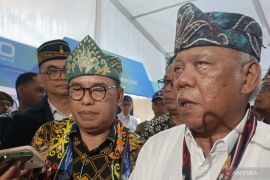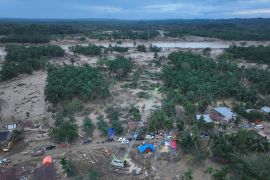Orangutan is one of Indonesia’s endemic primate species that is known for its intelligence. This animal is the only primate of the great ape species in Asia.
Outside Indonesia, chimpanzees are claimed to be the most intelligent creatures in the world after humans.
The chimpanzee, often abbreviated as “chimp”, is the common name for the two surviving species of apes in the genus Pan. The Congo River has been built as the boundary of the natural habitat of these two species: the common chimpanzee (Pan troglodytes) in West and Central Africa as well as the Bonobo (Pan paniscus) in the forests of the Democratic Republic of Congo.
So far, people in Indonesia are only aware of the two species of orangutan: the orangutan on the Kalimantan or Borneo Island and the other one on Sumatra Island.
Scientifically, scientists agree to classify the orangutan that lives in Kalimantan as Pongo pygmaeus while they call the orangutan that lives in Sumatra as Pongo abelii.
Based on the government website https://indonesia.go.id, Kalimantan has three subspecies of orangutans: Pongo pygmaeus pygmaeus that found in the northern part of Kapuas River to the northeast of Sarawak region of Malaysia, Pongo pygmaeus wurmbii found in the south of the Kapuas River to the west of Barito River, and Pongo pygmaeus morio found in abundance in the Sabah region of Malaysia to the south reaching the Mahakam River in East Kalimantan.
Related news: Aceh Police investigators apprehend four orangutan traffickers
In Kalimantan, orangutans can be found in almost all lowland forests, except for South Kalimantan, Brunei Darussalam, and few of them are also found in the Sabah and Sarawak regions of Malaysia.
Meanwhile, in Sumatra, orangutans only occupy the northern part of the island, from Timang Gajah in Central Aceh to the Sitinjak area in South Tapanuli.
Pongo tapanuliensis
In its development, it turns out that Indonesia has another species of orangutan, known as the “orangutan Tapanuli” (Pongo tapanuliensis).
Although their habitat is the island of Sumatra, but the species of Tapanuli orangutan is different.
From the morphology and behavior, the Tapanuli orangutan has a smoother skull and jawbone than the Sumatran and Kalimantan orangutans. It also has thicker and curly fur.
The male Tapanuli orangutan has a prominent mustache and beard with flat cheek pads covered with fine blond hair.
Based on their habitat, this new species of orangutan can only be found in the Batang Toru ecosystem spanning three districts: North Tapanuli, Central Tapanuli, and South Tapanuli.
On the indonesia.go.id page, it is stated that the discovery of these three orangutan species began with research on the Sumatran orangutan population, as a result of collaboration between the Ministry of Environment and Forestry, the Indonesian Institute of Sciences, the Bogor Institute of Agriculture, the National University, and the Foundation for the Sustainable Ecosystem-Sumatran Orangutan Conservation Program, which has been ongoing since 1997.
Earlier, the orangutans in Tapanuli forest were considered the southernmost orangutan population of the Sumatran orangutan, including the Pongo abelii.
Referring to the source sumatranorangutan.org, genetic differences are the first reason to distinguish the Tapanuli orangutan from the Pongo abelii species.
Historically, it is said that the genetic separation from the Sumatran orangutan occurred around 3.38 million years ago, while the separation from the Bornean orangutan occurred about 670,000 years ago.
Related news: BKSDA rescues three abandoned orangutans in Sampit, Central Kalimantan
The research also indicates that the Tapanuli orangutan is actually the ancestor of the great ape.
Flagship species
The ministry’s director general of natural resources and ecosystem conservation, Wiratno, highlighted optimism in every effort for wildlife conservation, including for orangutans.
This message was delivered when he was attending the release of five orangutans at the Bukit Baka Bukit Raya National Park in Kalimantan to coincide with World Orangutan Day on August 19, 2021.
"The orangutan is one of the 'flagship species' that continues to be a priority for the Ministry of Environment and Forestry through various conservation efforts, so that its existence in nature is maintained and reproduces well," Wiratno remarked.
He also underlined the importance of common awareness that conservation efforts cannot be made singlehandedly. Hence, cooperation between related parties, such as local governments, other ministries and institutions, universities, local communities, businesspersons, community institutions, and the media is very important.
Orangutan is one of Indonesia's endemic species, which are an important part of Indonesia's biological wealth. Currently, there are three known species of orangutan: the Sumatran orangutan (Pongo abelii), Bornean orangutan (Pongo pygmaeus), and Tapanuli orangutan (Pongo tapanuliensis).
The IUCN Red List classifies all three species in the “Critically Endangered” category in 2017, and they are included in the "Protected" category by Minister of Environment and Forestry Regulation no.106/Menlhk/2018 on Protected Plants and Animals.
Hence, the commemoration of World Orangutan Day is an opportunity to invite the public to be heedful of protecting the habitats and existence of orangutans to prevent these species from becoming extinct.
Related news: Protecting Orangutans in natural habitat deemed crucial
Editor: Rahmad Nasution
Copyright © ANTARA 2021












